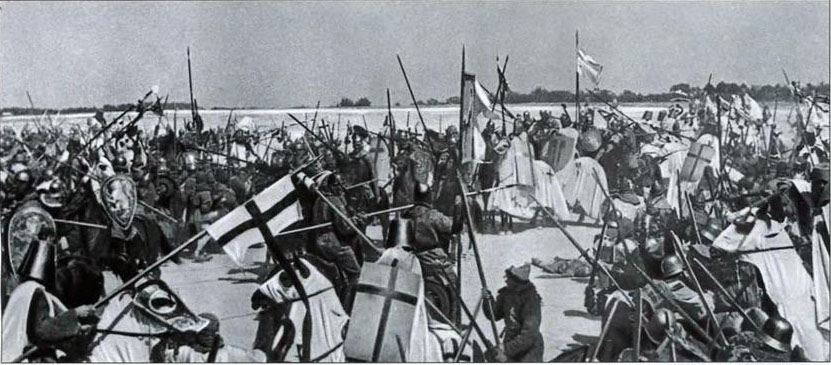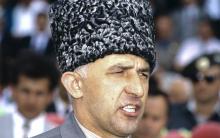5 238
In the XI - XIII centuries. The Catholic Church organized the crusades, the goal of which was the liberation of Palestine and the “Holy Sepulcher” from Muslims, which, according to legend, was located in Jerusalem. The true goal of the campaigns was to seize lands and plunder the eastern countries, the wealth of which was much talked about in Europe at that time.
In the armies of the crusaders, with the blessing of the Pope, special monastic-knightly organizations were created: they were called spiritual-knightly orders. Upon entering the order, the knight remained a warrior, but took the usual vow of monasticism: he could not have a family. From that time on, he unquestioningly obeyed the head of the order, the grandmaster, or grand master.
The orders were subordinate directly to the pope, and not to the rulers on whose lands their possessions were located. Having captured vast territories in the East, the orders launched extensive activities in the “holy land”.
The knights enslaved the peasants, both local and those who came with them from Europe. By robbing cities and villages, engaging in usury, and exploiting the local population, the orders accumulated enormous wealth. Large estates in Europe were bought with the stolen gold. Gradually the orders turned into the richest corporations.
The first was founded in 1119 by the Order of the Templars (templars). Initially, it was located not far from the place where, according to legend, the Jerusalem Temple stood. Soon he became the richest.
Going on a crusade, large feudal lords and knights often pledged their lands and other property in the European offices of the order. Fearing robbery on the way, they only took a receipt in order to receive the money upon arrival in Jerusalem. So the Templars became not only moneylenders, but also organizers of banking. And it brought them enormous wealth: after all, many crusaders died on the way, not having time to reach Jerusalem...
The second was the Order of the St. John the Hospitallers. It got its name from St. John's Hospital, which helped sick pilgrims. At the end of the 21st century. The third Teutonic Order was formed. Later he moved to the shores of the Baltic Sea, where in 1237 he united with the Order of the Swordsmen. The United Order of the Swordsmen brutally exterminated and plundered the local Lithuanian, Latvian, and Estonian tribes. He tried to seize Russian lands in the 13th century, but Prince Alexander Nevsky defeated the knightly army on the ice of Lake Peipsi on April 5, 1242.

In the XI - XII centuries. Three orders arose in Spain. They were created by the knights in connection with the Reconquista - the struggle aimed at expelling the Arabs from Spain.
In the XIV - XV centuries. European kings, creating centralized states, also subjugated the spiritual knightly orders. Thus, the French king Philip IV the Handsome brutally dealt with the richest of them - the Order of the Templars. In 1307, the Templars were accused of heresy. Many of them were burned at the stake, the property of the order was confiscated, adding to the royal treasury. But individual orders have survived to this day. For example, in Rome there still exists the Order of St. John - this is a reactionary clerical (church) institution.
CHILDREN'S CRUSADES

In 1096, all of them went to Palestine to fight against the Seljuk Turks, who shortly before had captured the city of Jerusalem, which was considered sacred by Christians. According to legend, the tomb of Jesus Christ, the mythical founder of the Christian religion, was supposedly located there. The liberation of this shrine served as a pretext for the Crusades. The crusaders attached cloth crosses to their clothes as a sign that they were going to war for the religious purpose of expelling infidels (Muslims) from Jerusalem and other sacred places for Christians in Palestine.
In reality, the goals of the crusaders were not only religious. By the 11th century. land in Western Europe was divided between secular and ecclesiastical feudal lords. According to custom, only his eldest son could inherit the lord's land. As a result, a large layer of feudal lords who did not have land was formed. They were eager to get it in any way. The Catholic Church, not without reason, feared that these knights would encroach on its vast possessions. In addition, the churchmen, led by the Pope, sought to extend their influence to new territories and profit from them. Rumors about the riches of the countries of the Eastern Mediterranean, which were spread by pilgrim travelers who visited Palestine, aroused the greed of the knights. The popes took advantage of this, throwing out the cry “To the East!” ". In the plans of the crusader knights, the liberation of the “Holy Sepulcher” was of secondary importance: the feudal lords sought to seize overseas lands, cities, and wealth.
At first, the poor peasants also took part in the crusades, suffering cruelly from the oppression of feudal lords, crop failures and famine. Dark, poverty-stricken farmers, mostly serfs, listening to the sermons of churchmen, believed that all the disasters they experienced were sent down on them by God for some unknown sins. Priests and monks assured that if the crusaders managed to win the “Holy Sepulcher” from the Muslims, then Almighty God would take pity on the poor and ease their lot. The Church promised the crusaders forgiveness of sins, and in case of death, a sure place in paradise.
Already during the first crusade, tens of thousands of poor people died, and only a few of them reached Jerusalem along with strong knightly militias. When the crusaders captured this city and other coastal cities of Syria and Palestine in 1099, all the wealth went only to the large feudal lords and knighthood. Having seized the fertile lands and flourishing trading cities of the “Holy Land,” as Europeans then called Palestine, the “warriors of Christ” founded their states.
The newcomer peasants received almost nothing, and therefore, in the future, fewer and fewer peasants participated in the crusades.
In the 12th century. the knights had to equip themselves for war many times under the sign of the cross in order to retain the captured territories.
However, all these crusades failed. When at the beginning of the 13th century. French, Italian and German knights girded themselves with swords for the fourth time at the call of Pope Innocent III; they did not go against Muslims, but attacked the Christian state of Byzantium. In April 1204, the knights captured its capital, Constantinople, and plundered it, showing what all the pompous phrases about saving the “Holy Sepulcher” were worth. Eight years after this shameful event, the Children's Crusades took place. Medieval monastic chroniclers talk about them like this. In May 1212, a twelve-year-old shepherd boy, Etienne, came from out of nowhere to the Abbey of St. Dionysius in Paris. He announced that he had been sent by God himself to lead the children’s campaign against the “infidels” in the “Holy Land.” Then this little boy went through villages and towns. In squares, at crossroads, and in all public places, he made passionate speeches to crowds of people, calling on his peers to get ready for the journey to the “Holy Sepulcher.” He said: “Adult crusaders are bad people, greedy and selfish sinners. No matter how much they fight for Jerusalem, nothing works out for them: the omnipotent God does not want to grant sinners victory over the infidels. Only blameless children can receive God's mercy. Without any weapons they will be able to liberate Jerusalem from the rule of the Sultan. At the command of God, the Mediterranean Sea will part before them, and they will cross the dry bottom, like the biblical hero Moses, and take away the “holy tomb” from the infidels.
“Jesus himself came to me in a dream and revealed that children would deliver Jerusalem from the yoke of the pagans,” said the shepherd boy. For greater persuasiveness, he raised some kind of letter above his head. “Here is the letter,” Etienne asserted, “which the savior gave me, instructing me to lead you in an overseas campaign for the glory of God.” Right there, right in front of numerous listeners, chronicles tell that Etienne performed various “miracles”: he allegedly restored sight to the blind and healed cripples from illnesses with one touch of his hands.
Etienne became widely known in France. At his call, crowds of boys moved to the city of Vendôme, which became a rallying point for young crusaders.
The naive stories of chroniclers do not explain where such amazing religious zeal among children came from. Meanwhile, the reasons were the same that at one time prompted the poor peasants to be the first to move to the East. And although the movement of the Crusaders in the 13th century. was already discredited by the predatory “exploits” and major failures of the knights and was on the decline, yet the people did not completely extinguish the belief that God would be more merciful if they managed to recapture the holy city of Jerusalem. This belief was strongly supported by church ministers. Priests and monks sought to extinguish the growing discontent of the serfs against their masters with the help of a “deed pleasing to God” - the crusades.
Behind the holy fool (mentally ill) shepherd Etienne were clever churchmen. It was not difficult for them to teach him to perform previously prepared “miracles.” Crusader “fever” gripped tens of thousands of poor children, first in France and then in Germany. The fate of the young crusaders turned out to be very deplorable. 30 thousand children followed the shepherd Etienne.












The most beautiful motorcycles in the world
Which sea is the cleanest in the world?
Top 10 Most Expensive Furs
The largest and most luxurious casinos in the world
Knightly orders of Europe XI - XIII centuries